3D printing as a manufacturing method has developed tremendously over the past decade. Although some remain skeptical about the industry’s potential, NASA – the world’s preeminent space research and exploration organization – is over the moon with 3D printers. Not only has NASA embraced existing technologies (there are 3D printed parts currently on Mars), they are actively working to take additive manufacturing to the next level through funding, research, and practical application.
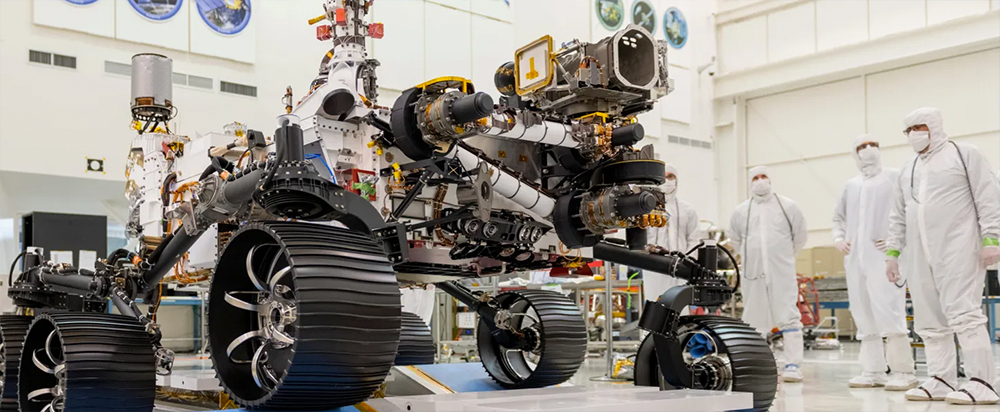
Although NASA has already demonstrated additive manufacturing’s capability for producing parts for space missions, the agency isn’t done innovating. NASA is one of the biggest backers and most enthusiastic supporters of 3D printing and has put a lot of faith in 3D printing’s ability to make its mission easier and cheaper. The organization is constantly looking to push the limits through experimentation, research and development, and by providing funding to outside projects and innovators.
NASA has found that 3D printing can offer a solution to many issues facing mankind’s ventures into deep space. The agency trusts the technology and is constantly striving to take it where no manufacturing method has gone before.
The results demonstrate the maturity and effectiveness of 3D printing technologies in challenging applications. And really, if it’s good enough for NASA, 3D printing is definitely more than enough for any industries based on terra firma.
Let’s take a look at the projects, products, and progress going on at NASA that’s moving the entire 3D printing industry forward.
NASA's Latest Work in 3D Printing
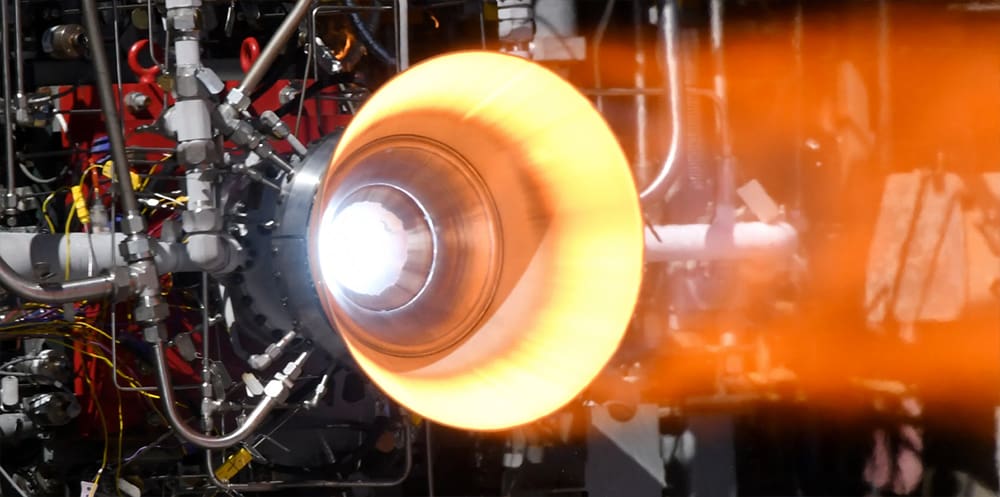
3D Printed Rocket Engine Hardware
Last month, NASA tested rocket engine parts developed in partnership with Aerojet Rocketdyne, a California-based aerospace manufacturer that uses metal additive manufacturing methods. The development team has been designing and manufacturing lightweight combustion chambers, along with nozzles and injectors that will be made with 3D printing technologies. The new combustion chamber and nozzle went through cold spray and hot-fire testing and passed both with flying colors.
The main combustion chamber experienced pressures up to 750 pound-force per square inch (psi) for all tests conducted, and calculated hot gas temperatures approaching 3427ºC.
Aerojet Rocketdyne has more than 20 years invested in additive manufacturing technology, which it says dramatically reduces the amount of touch labor required to build many engine components so it can provide more affordable products. “Components that once took hundreds of hours to produce with traditional manufacturing techniques can now be built in just days using a single machine. This reduces lead times significantly and allows us to bring our products to market more quickly,” the company says.
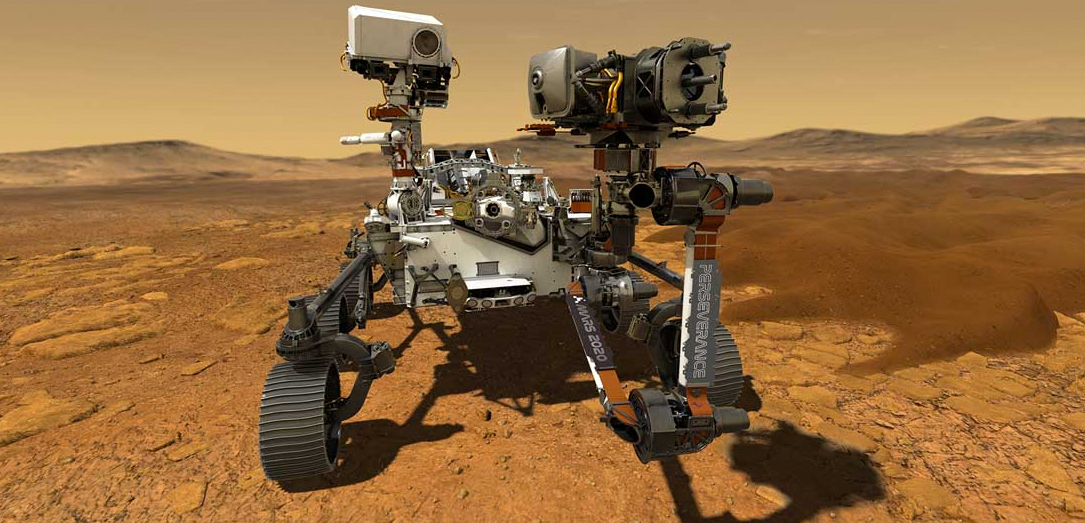
Exploration Rover on Mars
When the Perseverance Rover (know as Percy) landed on Mars on Feb. 18, 2021, it brought with it 11 3D printed metal parts. Five of the parts, printed from titanium, form the shell of the PIXL instrument that looks for signs of fossilized microbial life on Mars. The other six nickel superalloy parts can be found in Percy’s MOXIE module’s heat exchangers. MOXIE creates oxygen by superheating Martian air and could, in the future, produce industrial quantities of oxygen on Mars.
The PIXL parts, which were 3D printed Carpenter Additive, made the instrument three to four times lighter than it would have been with conventionally produced parts. The MOXIE heat exchangers were each 3D printed as a single piece, whereas with conventionally machined heat exchangers they would need to be made out of two parts and welded together.
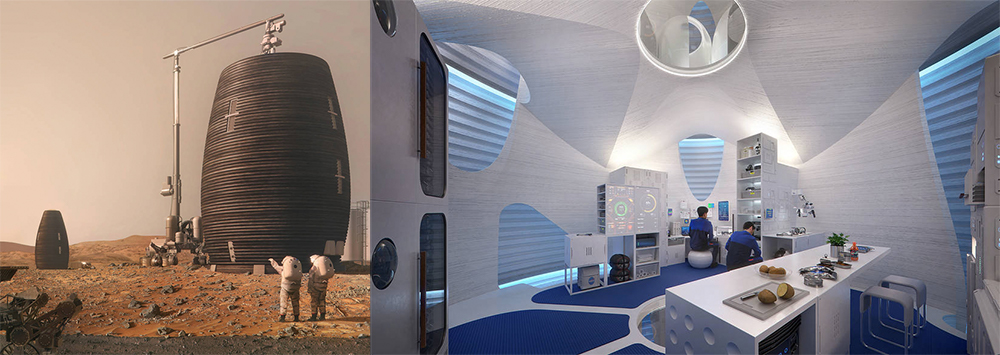
3D Printed Habitats on Mars
In a 2019 NASA program, the 3D Printed Habitat Challenge, found groundbreaking ways to use 3D printing to create habitats for a future Mars mission. The winner of the Challenge was AI SpaceFactory that created a method to 3D print a multi-story house on Mars using basalt fiber extracted from Martian rocks and PLA bioplastic produced from plants grown on Mars. The material is two to three times stronger and five times more durable than concrete.
“We developed these technologies for space, but they have the potential to transform the way we build on Earth,” says David Malott, CEO and founder of AI SpaceFactory. “By using natural, biodegradable materials grown from crops, we could eliminate the building industry’s massive waste of unrecyclable concrete and restore our planet.” In fact, the company took the technology it developed for NASA and is working on 3D printed homes that are not only made of sustainable materials but are also fully recyclable.

3D Printed Human Tissue
NASA’s just-concluded Vascular Tissue Challenge also pushed the boundaries of 3D printing, although in a slightly different direction. Both the first- and second-place finalists used 3D printing to create gel-like molds to grow a cube-shaped piece of human liver tissue that could survive inside the human body. According to NASA, the technologies used to create the tissue pieces could lead to improved pharmaceutical research, and in the long run to fully 3D printed artificial transplant organs.
“I cannot overstate what an impressive accomplishment this is,” says Jim Reuter, NASA associate administrator for space technology. “It will be exceptional to hear about the first artificial organ transplant one day and think this novel NASA challenge might have played a small role in making it happen.”
3D Printing for Construction on the Moon
Icon, the 3D printed house company, announced last fall that it has been awarded funding from NASA to begin research and development of a space-based construction system that could support future habitats on the moon – known as Project Olympus. Known for its advanced 3D printing technology for homebuilding on Earth, Icon is currently developing a full-scale additive construction system that could print infrastructure on the Moon.
“NASA’s investment in space-age technologies like this can not only help to advance humanity’s future in space but also to solve very real, vexing problems we face on Earth,” says Jason Ballard, co-founder and CEO of Icon.
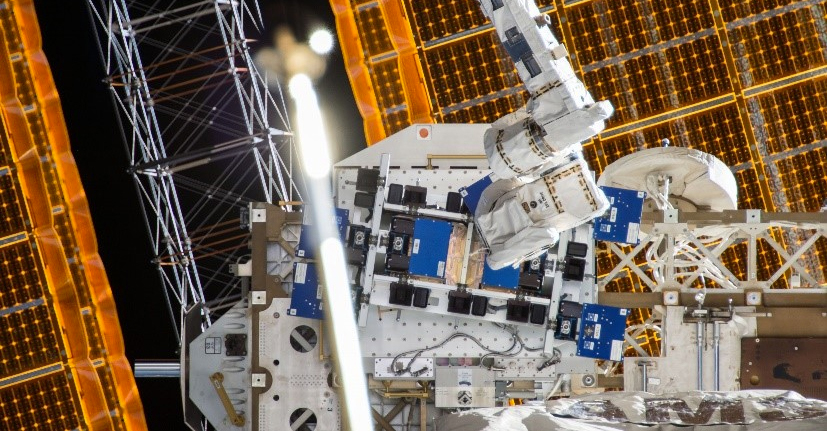
Additively manufactured electronics manufacturer Nano Dimension’s 3D printed integrated radiofrequency (RF) circuit has been flown to the International Space Station for space effects studies. Printed on Nano Dimension’s DragonFly LDM system, the circuit will transmit data to and from the ISS, providing the project partners with systematic analysis of the RF properties of 3D printed High-Performance Electronic Devices (Hi-PEDs) within the rigors and demands of space.
Nano Dimension collaborated with communications technology firm L3Harris on the two-year project, which ultimately aims to demonstrate the viability of using new technologies in space.
Binder Jetting with Moon Dust & Other NASA-Funded Research
In May 2021, NASA’s Space Technology Mission Directorate (STMD) awarded $105 million in funding to dozens of small U.S. businesses, including 36 space 3D printing projects.
These groundbreaking projects include – among others – Physical Sciences’ partnership with MIT to 3D print with molten moon dust, Nanovox’s 3D printed space sensors, and Mainstream Engineering Corporations’ in-situ printed spacecraft thermal protection systems. All of these projects tackle a demanding space engineering problem, and NASA believes 3D printing to be the answer.
It has become something of a tradition for NASA-backed technologies to eventually end up in everyday use in mainstream markets. There’s no reason to doubt that the same will happen with these additive manufacturing technologies. Getting the green light from NASA can only serve as proof of 3D printing’s maturity and propel the industry forward.
3D Printed Things in Space Right Now

3D Printing in Space at the ISS
3D printers are now floating in a tin can far above the world. In fact, Redwire’s first commercial microgravity plastic 3D printer was launched to the International Space Station (ISS) in 2016. Since that time, it has provided in-orbit fabrication services and printed more than 200 tools and essential spare parts for the ISS, which has, shall we say, very limited supply chain options.
Waiting weeks or months for critical maintenance supplies to be ferried up from earth isn’t often feasible. As humans venture farther into the solar system, these cargo resupply missions will become more costly and complex, compelling NASA to consider alternate options for spacecraft supplies. “The ability to 3D print parts and tools on demand will dramatically reduce the time it takes to get parts to orbit and increase the reliability and safety of space missions, while dropping costs,” says Redwire division Made in Space, the manufacturer of all of ISS’s 3D printers.
The Additive Manufacturing Facility (AMF) located on the ISS produces parts from ABS plastic using FDM printing. In 2020, MIS introduced the Ceramic Manufacturing Module, which prints pre-ceramic resins using SLA. MIS technology has been used, for example, to print radiation shielding for ISS’s expandable habitat modules.

3D Printed Rocket Engines
Later this year, California-headquartered aerospace company Rocket Lab will launch a CubeSat satellite to the lunar orbit for NASA as part of the Artemis program, which seeks to put the first woman on the moon by 2024. Rocket Lab developed the world’s first 3D printed rocket engine, called the Rutherford, which is printed using electron beam melding. This engine powers the company’s own Electron delivery rocket. To date, Rocket Lab has delivered 104 satellites to space, including its another NASA-sponsored delivery in 2018.
Just this month, Rocket Lab announced that it was awarded a contract to develop two Photon spacecraft for NASA’s ESCAPADE mission to Mars in 2024 – so they have about two years to prepare. “Planetary science missions have traditionally costed hundreds of millions of dollars and taken up to a decade to come to fruition,” Rocket Lab founder and CEO, Peter Beck says. “Our Photon spacecraft for ESCAPADE will demonstrate a more cost-effective approach to planetary exploration that will increase the science community’s access to our solar system for the better.”
In September 2019, the first Seeker free-flying inspection robot operated around the Cygnus cargo spacecraft. This ultra-low-cost inspector unit is based on CubeSat platform, and it contains 3D printed parts. Ohio-based manufacturing firm The Technology House (TTH) designed and printed four thrusters for the Seeker using Cyanate Ester 221. This was the first time a plastic material was able to meet NASA’s rigorous standards, against even the agency’s own expectations. But TTH and 3D printing rose to the challenge and delivered.
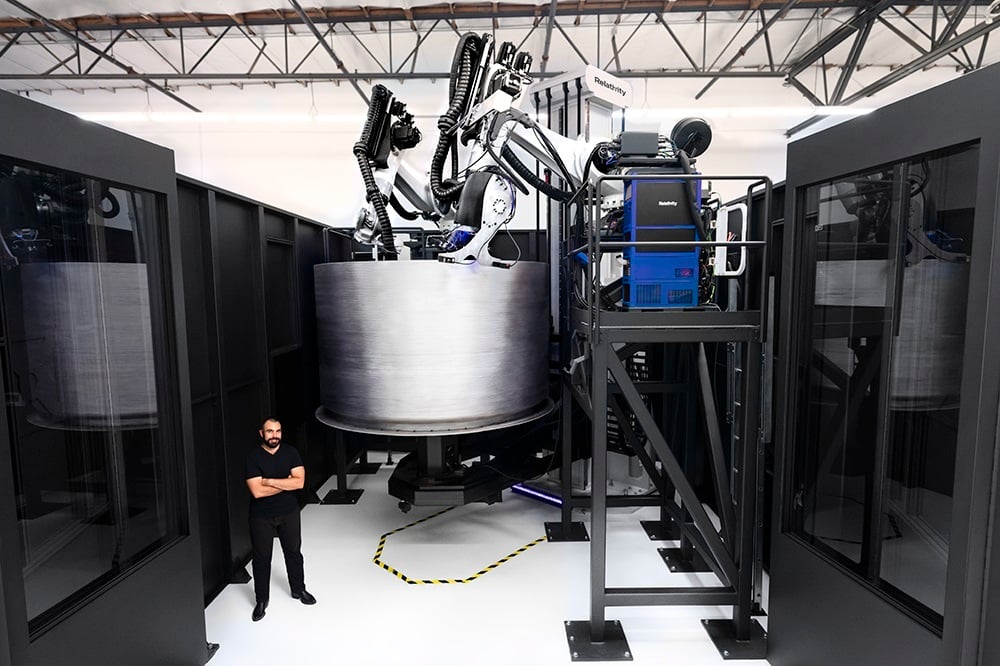
One of the better-known NASA contractors is Relativity Space. The company developed the first entirely 3D printed rocket – Terran 1 – and its successor, the reusable Terran R. The rockets are produced at the Stargate facility, where Relativity Space operates the world’s largest metal 3D printer that prints in proprietary metal alloys. Relativity Space has received $3 million in funding from NASA for launching CubeSats, and in 2020, it partnered with NASA and Lockheed Martin to launch a Terran 1 rocket to demonstrate in-orbit refueling technology.
How NASA 3D Prints?
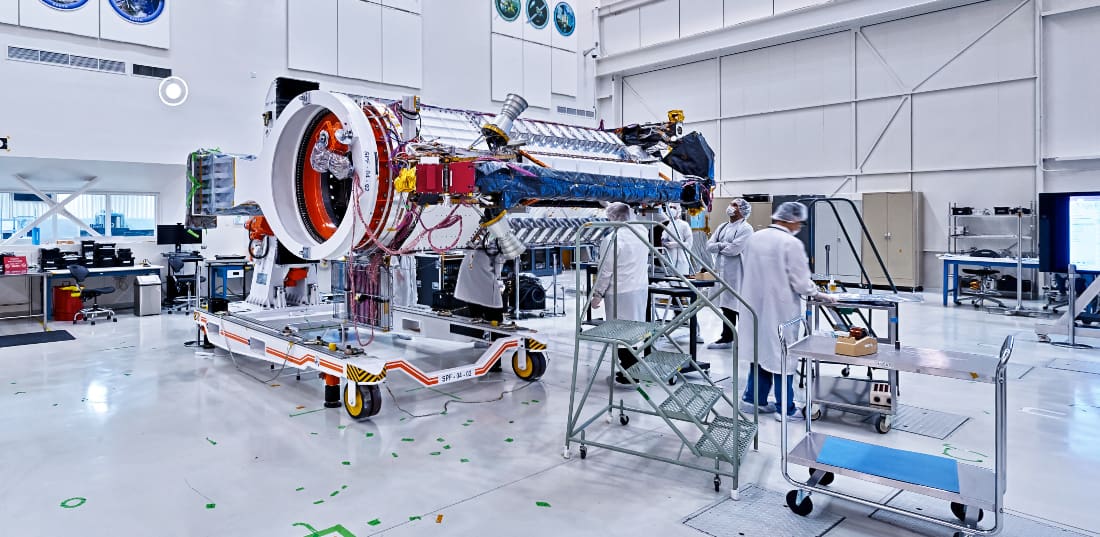
When it comes to operating 3D printers, NASA’s efforts follow one of three different avenues. NASA does 3D printing in its own R&D facilities, the foremost of which is the Jet Propulsion Laboratory (JPL), located in California, which has its own Additive Manufacturing Center. Many other NASA centers also work in this field, like the Marshall Space Flight Center (MSFC) in Alabama.
In addition to producing parts on its own, NASA regularly hires third-party companies as contractors. We’ve already touched upon this with Rocket Lab and TTH, but there are also so many other companies and research teams working for NASA that we couldn’t possibly list them all here.
Finally, NASA does 3D printing in space itself, as we’ve already mentioned. Since 2014, the International Space Station (ISS) has housed a 3D printer for the on-site printing of replacement parts.
NASA's 3D Printed Metals and Plastics
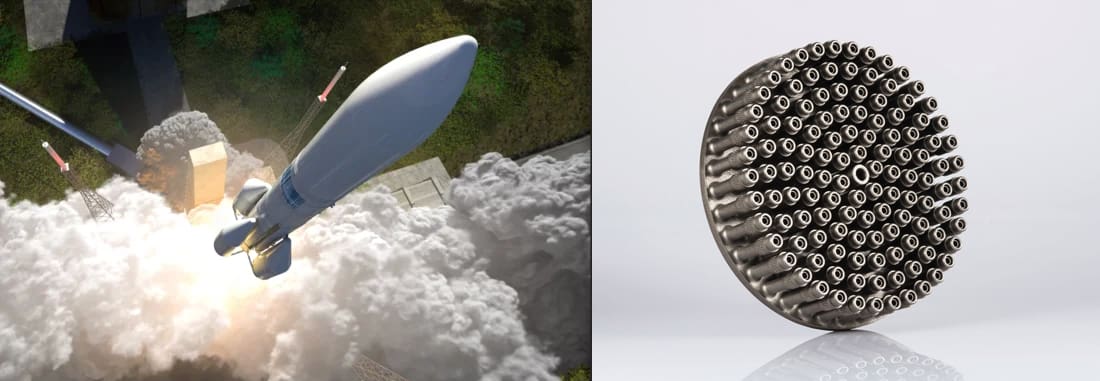
When it comes to launching rockets, once factor is perhaps above all others in importance – weight. The less weight you have to get up from the ground, the less fuel you need, and the cheaper the launch gets. In fact, shaving one pound off of payload weight cuts launch costs by more than $10,000. It’s no surprise, then, that NASA prefers materials that can make parts as lightweight and consolidated as possible.
The metal of choice for NASA in 3D printing is usually titanium, due to its high strength, low weight, and excellent corrosion resistance.
Chicago, Illinois-based additive manufacturing firm Sciaky partnered with NASA contractor Lockheed-Martin in 2018, providing its Electron Beam Additive Manufacturing (EBAM) technology. Using EBAM, Lockheed-Martin 3D printed large 46-inch satellite fuel tanks out of titanium. The tanks were capable of meeting NASA’s stringent requirements vis-à-vis weight and strength, and at the time they became the largest 3D printed parts approved for space launches.
Other times, a single metal material can’t perform adequately and NASA has to rely on both common and customized metal alloys. A great example of this is when additive manufacturer EOS helped ArianeGroup develop a new IN718 nickel-alloy-based injection nozzle for rocket engines. IN718 provides high resistance to extreme temperatures encountered during a rocket launch, and it allowed for considerably thinner wall thicknesses that significantly reduced part weight. As a result, the new nozzle is 50% cheaper than the previous part. In 2020, NASA contracted ArianeGroup to deliver propulsion system components for the Artemis moon mission, including engines.
Aerojet Rocketdyne is another company providing engines for the Artemis program, including its RL10 engine. In 2017, Aerojet developed a new additively manufactured thrust chamber for the RL10, printed out of copper alloy with the SLM technology. Aerojet Additive Manufacturing Program Manager Jeff Haynes believed that the company had 3D printed the largest, successfully tested copper-alloy thrust chamber. The company chose copper alloy due to the material’s excellent heat transfer properties, which allowed it to create a more compact and lighter engine. Additionally, the new engine can be printed in two parts, which reduced part count by 90%.
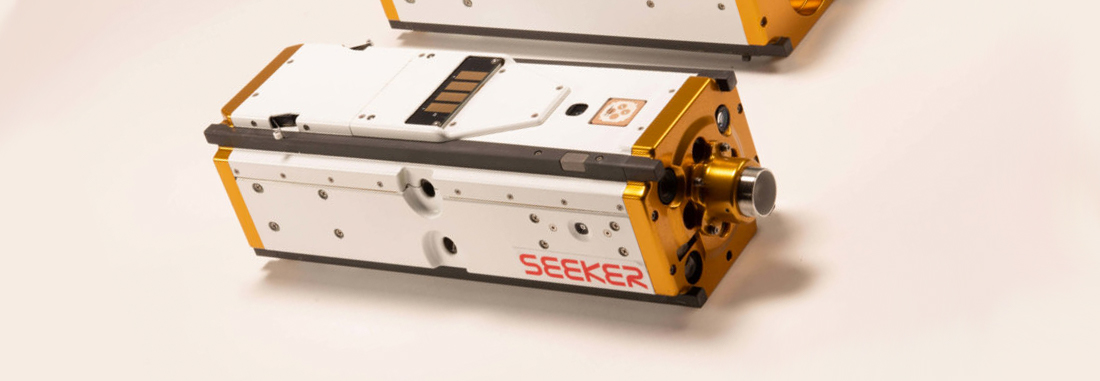
It’s not all about metal, though – sometimes plastics can get the job done even better. A great example of this are the TTH-manufactured thrusters for the Seeker robot, which we already mentioned. TTH utilized Carbon’s M2 3D printer in conjunction with Cyanate Ester 221 (CE 221) to produce four high-performance thrusters for the cold-gas propulsion system within the Seeker robots for NASA. Prior to this case, NASA had never approved 3D printed pressurized plastic parts for space applications. In fact, NASA was skeptical that non-metallic materials could ever meet its requirements. However, after rigorous testing and both material and part design development, met or exceeded all of NASA’s requirements. The project demonstrated 3D printable plastic materials’ suitability for space flight, and opened the doors for further research into fast, low-cost, and mechanically efficient plastic parts.
How Does NASA Design for 3D Printing?
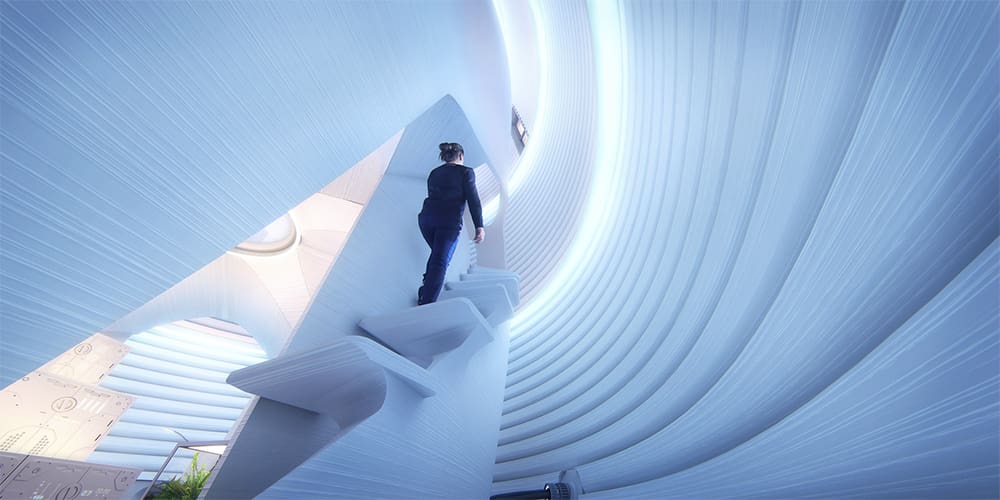
As we mentioned, any additively manufactured components on spacecrafts must be as optimized as possible to provide the highest grade of functionality, production speed, and cost savings. To this end, NASA utilizes a great variety of 3D printing design techniques and technologies. The agency’s own Additive Manufacturing Center works constantly to develop new approaches to creating lattice structures, topology optimization, and design for additive manufacturing (DfAM).
Creating a metal part that is optimized to reduce weight is incredibly important to reduce the immense cost of launching a vehicle, but those optimized designs are usually very spiderlike in their final form. To machine a part like that out of a stock shape can frequently result in 90% or more of the material going to waste in order to make that highly complex, lightweight part. So you are saving in one area at the expense of another. Being able to print that spiderlike, topologically optimized part without incurring the material waste enables NASA to get to that goal of mass reduction without the waste penalty.
That’s not to say NASA doesn’t also rely on outside help. Simulia Dassault Systemes (3DS) and Stratasys collaborated on a topology optimization design study for NASA in 2016. The optimized object was a circuit box. The collaborators created a 3D model of the original box, and used 3DS’s Tosca software suite to utilize generative design and find ways to optimize the part’s topology. The optimized part featured organic, curved surfaces and holes that reduced material consumption while retaining the part’s functionality. Although never put into action, the final topologically optimized and print-prepared design was 30% lighter at 315 grams.

Stratasys also contributed to another part that actually went into space. The company developed an external support shell for satellite antenna arrays. The project included both finding the optimal design and replacing the original astroquartz material. Stratasys settled on the ULTEM 9085 resin for the part. The company, working closely with NASA’S JPL, used iterative design to process multiple variants of the shell’s STL file before arriving at its final form. In the end, 30 antenna arrays were delivered to NASA.
We also can’t ignore the 3D printed PIXL shell that landed on Mars, as its origin story provides a great example of a design process that starts at NASA and ends with an outside contributor. NASA JPL created the initial design of the shell, which focused completely on functionality. NASA then hired Carpenter Additive to optimize the part for production. Carpenter says staying within NASA’s mass budget was challenging, but after plenty of experimentation – including several design variations of an internal lattice structure – they created a design that was sufficiently light, 3D printable, and had an optimized structure that could withstand the harsh condition of a Mars landing. The design pushed the limits of thin-wall strength, but thanks to the innovative use of both lattices and selectively thickened walls, the PIXL shell is now on the Red Planet.
License: The text of "3D Printing & Space: NASA Takes the Lead" by All3DP Pro is licensed under a Creative Commons Attribution 4.0 International License.
